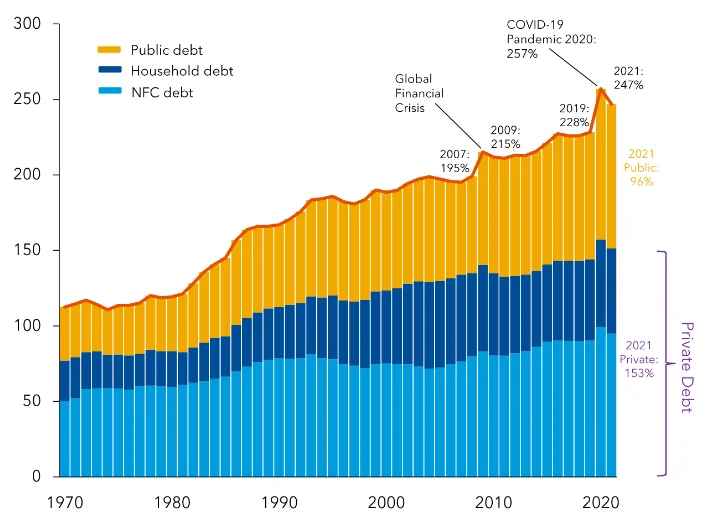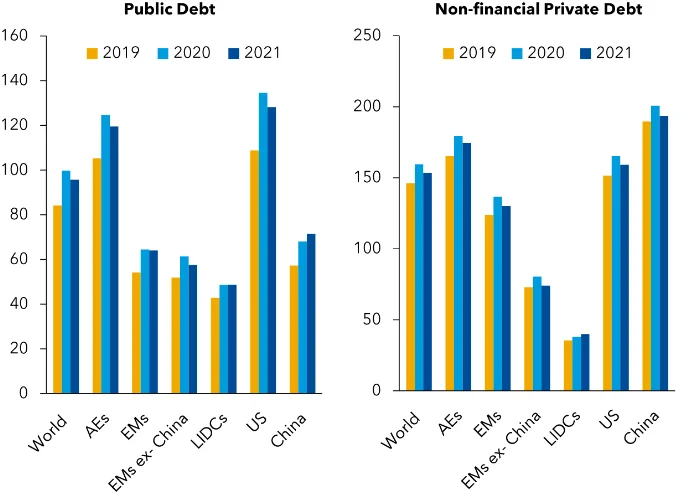The world is neck-deep in debt. Well, public debt is not something new, and the recent pandemic strike paved way for the debt rate to double reaching as huge as the entire global economy. The International Monetary Fund (IMF) recorded the global debt-to-GDP to hit a high of 256% in the post-Covid 19 times, up from 195% during the 2007 Global Financial Crisis (GFC).
According to IMF reports, which have been released yearly since 2016, private debt, which includes non-financial company and household commitments, drove the total drop, falling by 6 percentage points to 153 percent of GDP. The reduction in public debt of 4 percentage points, to 96 percent of GDP, was the biggest in decades. The COVID-19 economic recovery and the subsequent rise in inflation are to blame for the abnormally significant fluctuations in debt ratios.
Yet, the global debt was still about 19 percent of GDP higher than pre-pandemic levels at the end of 2021, presenting difficulties for authorities everywhere. The continued addiction to debt could pose financial instabilities in various countries and affect future growth prospects. So, first things first, let us look at what exactly is public debt.

What is Public Debt and what are its effects?
Public debt is the fund borrowed by a government when it runs a budget deficit from various sources such as banks, organizations, and other countries. This public debt or sovereign debt helps the government in its developmental goals for the country. If a country keeps borrowing unduly, the debts will pile up and burdens the national expenditure. The government can procure funds domestically from individuals and financial institutions as well as foreign countries and international organizations.
When a government secures funds by distributing government securities, citizens would either invest in such assets or reduce their expenses, affecting the nation’s consumption expenditure. This is the Revenue Effect of sovereign debts.
The expenditure of the borrowed fund or public debt, on the other hand, is quite different from the tax revenue which is used for meeting regular expenses. The funds here will be used for welfare programs and the infrastructural development of the country. This is the Expenditure Effect. Public debt also impacts other aspects such as employment, production, distribution, consumption, and investment.
Why does the government borrow?
Just like people, governments borrow money for the country’s development and other needs so that their tax revenues and income won’t entirely be affected. Mostly government borrows funds for the following reasons
- Infrastructure development
- Support welfare schemes
- Meet the Budget Deficit
- Stimulate the growth of public corporations
- Finance the defense sector
Crunching Numbers
The debt dynamics varied from one country to another but according to the reports of the IMF, the fall in debt was the largest in the advanced or developed nations, where both the public debt and private debt of the individuals were reduced by 5 percent of GDP in the year 2021. Now, this data has reversed the recorded surge in 2020.
“The largest decline in debt was among advanced economies (AEs). Total debt declined on average by 10 percentage points of GDP, to 292 percent of GDP in 2021, driven by similar falls in public and private debt”, notes IMF.
“The fall in debt among emerging markets (EMs) was driven by private debt. Total debt-to-GDP fell, on average, 7 percentage points to 192 percent of GDP in 2021, matched by a reduction of similar size in private debt to 130 percent of GDP. EMs’ public debt remained broadly stable at around 64 percent of GDP”, records IMF’s Global Debt Monitor report.
2021 was significantly better as the private debt decreased to 247 percent of the GDP, falling nearly 10 points from its peak level during 2020, according to IMF’s Global Debt Database Update. Global debt, despite having a steep decrease in 2021, continued to rise (at a Slower pace) and reached $ 235 trillion. In developing countries, the total debt ratios repeatedly increased during 2021 due to higher private debt.

Why does the Sovereign Debt increase?
Public Debts have risen sharply since the global financial crisis, debts reached a record of $225 trillion from $116 trillion over the same period with public debts or government borrowing increasing rapidly much higher than private debts. Let us take a look at why there is an increase in government borrowing.
The substantial increase in borrowings was mainly due to the reduction in interest rates. The interest rate is the price of the money and a reduction in the interest rate means borrowing will be more inexpensive. The yields on the standard 10-year treasury fell above zero in 2020 from more than 4% in 2008 in the US. The pandemic and the global financial crisis made the central banks ease monetary policies, resulting in similar trends across the globe.
Fiscal and monetary policies that are introduced were usually used to handle the economic crisis earlier and as a result, the global economy was able to bring inflation under control. The world did see a good time with the stock market booming, a decline in the unemployment rate, and booming businesses, creating a general optimism with a willingness to take greater risks. Countries also borrow their own money and can always monetize the debt by paying it off with the newly created money. But this action is not without its consequences as the investors could force yields sharply higher and collapse currencies.
A close look at the world economy
With all this being mentioned, the trend of borrowing funds significantly increased especially after the pandemic, and the major banks such as the European Central Bank, Bank of Japan, Bank of England, and the Federal Reserve have debt purchase programs totaling 8 trillion euros. Governments utilized these to introduce stimulus programs. With the Russia-Ukraine war, the sudden Covid surge in China, and subsequent lockdowns once again added crisis to the economy. Japan’s government debt reached nearly 994 trillion in 2022 as the spending expenses surpassed the development of the nation. Almost the entire of Europe is currently having trouble with debt.
“At the planned rate of 15 billion a year, they would need 22 years to get rid of their entire debt portfolio,” states Paul De Grauwe, a professor at the London School of Economics. EU governments have drained nearly 680,000 million euros in assistance to organizations and consumers, which is 40% of German subsidies. All these crises the debt of the European region increased by nearly 93 percent during the third quarter of 2023. In Asia, countries such as Pakistan are on the verge of ruins and have asked IMF for financial aid. According to the World Bank, the poorest countries are already spending more than a tenth of their export revenues to serve their publicly guaranteed external debt.
Sri Lanka the previous year became the first Asian country to default on its debt of £63 million with creditors including China and India. The world also witnessed China emerging as one of the biggest mutual creditors. Most western countries on the other hand seem to have a safe grip on the matter. India, on the other hand, is getting ready to be the host of the G-20 presidency to address the external debt of these countries.
What’s the next step?
With these facts, and figures public debt may seem like a huge burden (it technically is, if we are not aware of the excessive rise in debt), but it does serve a crucial function in our economy. Public debt is a great help to the government to build the nation’s infrastructure, provide better education and healthcare facilities, and attract investment opportunities today through borrowing without having to wait for years. However, the increase in public debt also brought many economies to their knees.
Economies with comparatively higher volumes of debt continue to be comparatively well-off than the countries with moderate leverage struggle. This will also depend on the governments of the particular country and the debt associated with particular currencies. International financial institutions seek ways to uphold the economy. IMF urges the governments of various countries to move forward with fiscal plans and monetary policies that would return to the budgetary balance in the medium term while the World Bank urges to address the debts of the disadvantaged nations. The Organization of Economic Co-operation and Development (OECD) likewise insists on securing the sustainability of pensions.
For governments, managing gigantic public debt levels is going to be a massive task, especially when the economy decelerates, and the borrowing costs increase. Investors are also vigilant about the worsening macroeconomic fundamentals due to the recent fluctuations in the bond markets.
And what governments can do is, as mentioned earlier, adopt adequate fiscal policies that would bring the inflation of various countries under control along with a watch on debt vulnerabilities. This would also include the necessary action brought to support the most vulnerable or hardest hit by the cost-of-living crisis. This would ease the pressures of Central banks and would facilitate slight increases in interest rates without being too harsh on the lives of common people.


















